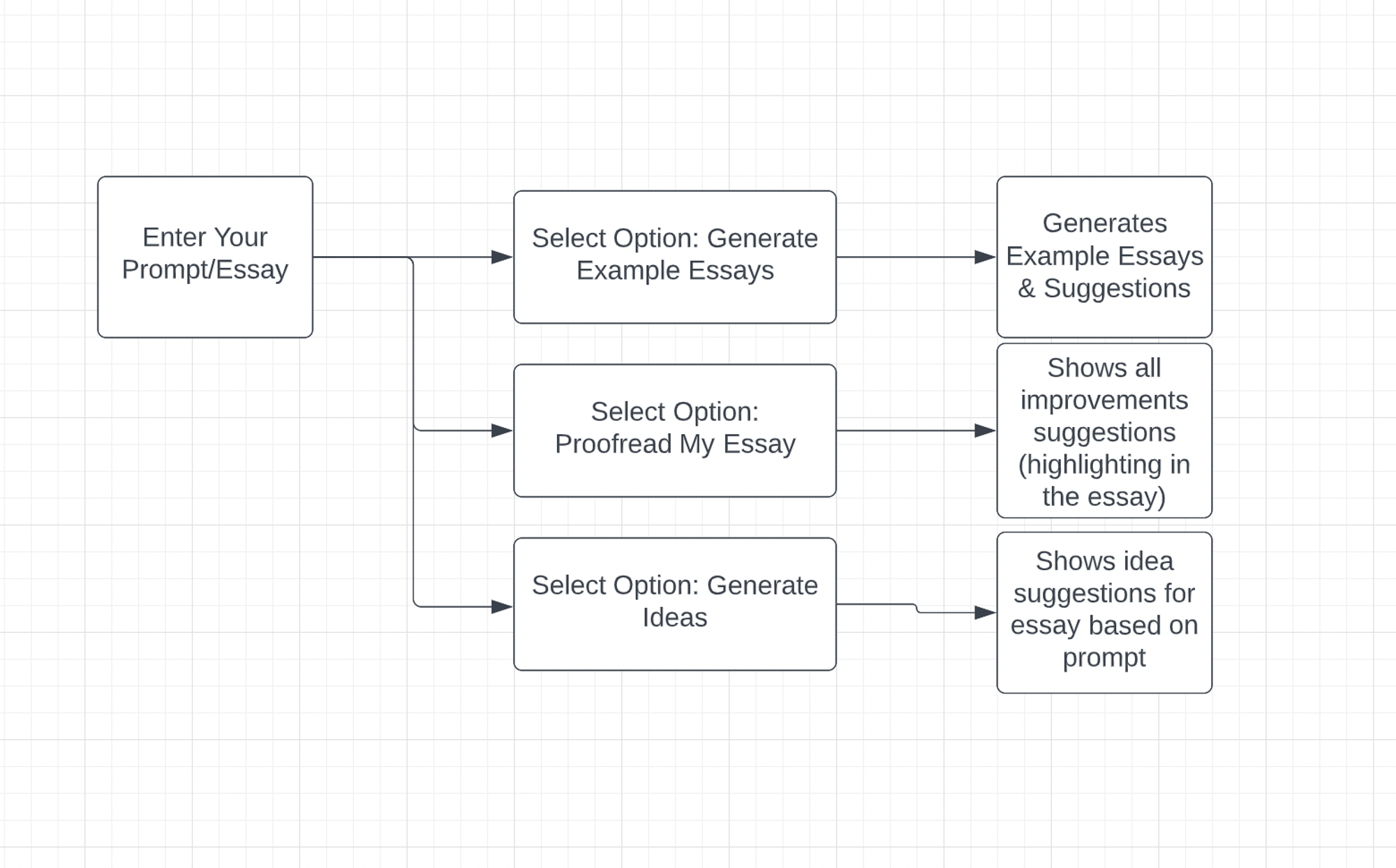Product Metaphor:
You focus on writing the essay while we take care of college research & grammar
Features:
Data-based insights into colleges and everything related to that, grammar fixes, improved sentence structures, overall rating of the essay, AI-generated essays based on the provided information, and actionable advice on improving the essay.
User Problem:
College admission seekers applying to ~10 colleges (~40 essays) lack the ability and time to research all colleges meaningfully and interpret all the data among time-constrained academic and personal priorities.
Product Description & Value Proposition:
Rubriked Essay Assistant is a tool that helps users to write better college admissions essays. It is designed for high school seniors, transfer students, and graduate admission seekers who are applying to colleges & universities; it’ll also empower college admissions counselors and tutors who can provide quick feedback to their mentees.
Currently, users can only access it as a web app. To get started, users will provide the assistant with a prompt/topic description/personal information, and the assistant will be able to do three things:
- Write an example essay based on the given information
- Provide them with suggestions and feedback in terms of grammar, structure, content, and style on their essay
- Provide insights into the college based on past data
The assistant can understand college admissions essays' structure, style, and content and generate appropriate and relevant responses to the user's prompts. It is powered by a powerful AI model that has been trained on a dataset of college admissions essays that worked.
Using the Rubriked Admissions Essay will equip applicants with personalized and actionable advice and help them to improve their writing skills and confidence. It also saves college admissions counselors and tutors’ time and effort, who can use the assistant to quickly and efficiently review and provide feedback on applicants' essays.
User Story:
- As a high school senior, Sarah is applying to colleges and needs to write a personal statement essay. She feels overwhelmed and unsure of how to start and decides to use the essay writing assistant to help her. She opens the assistant in her web browser and types in her prompt: "Describe a challenge you have faced and how you overcame it." The assistant gives her suggestions and feedback on her essay in real-time, helping her structure her essay, find the right words, and avoid common mistakes. Sarah is able to write a polished and compelling personal statement essay with the help of the assistant and feels confident and prepared when she submits her college applications.
- As a college admissions counselor, Maria reviews hundreds of application essays from high school seniors. She is looking for essays that are well-written, engaging, and relevant to the prompt, but she doesn't have time to read and provide feedback on every essay. She decides to use the essay writing assistant to help her quickly assess the quality and relevance of the essays. She opens the assistant in her web browser and selects a sample of essays from the pool of applicants. The assistant provides her with a summary and analysis of each essay, highlighting its strengths and weaknesses and suggesting improvements or alternative approaches. Maria can quickly and efficiently review the essays with the help of the assistant and can provide more detailed and personalized feedback to the applicants who need it most.
- As a tutor, Jake is helping his high school junior students to prepare for their college admissions essays. He knows that many of his students struggle with writing and expressing themselves, and he wants to provide them with a tool to help them improve their skills and confidence. He uses the essay writing assistant in his tutoring sessions and assigns his students a series of writing prompts and exercises. The students use the assistant to write and receive feedback on their essays, and Jake is able to monitor their progress and provide additional guidance and support. Jake's students are able to write better essays and feel more confident in their writing abilities, thanks to the assistance of the essay writing assistant.
Inclusiveness & Internationalization
Writing Levels: Rubriked Essay Assistant accommodates all users from different writing levels: beginner, intermediate, and advanced, providing them with tailored suggestions and feedback accordingly. Regardless of your expertise in writing skills, users will feel their ideas are communicated way better.
People with Disabilities: The assistant will be especially accessible to users with disabilities or special needs. For example, features such as text-to-speech, speech-to-text, and keyboard navigation, can help users with visual, auditory, or motor impairments to use the assistant more easily.
Applicants with Minimal Internet Usage Experience: Students who don’t have regular access to the internet might not be able to be up to date with College Info as well as others. Such barriers in the ability to browse the internet well and meaningfully keep them far from writing concise, personalized college essays. Our assistant will be able to give such applicants meaningful and relevant information in front of them without having to browse 100s of web pages.
Internationalization: Rubriked Essay Assistant is trained in a diverse collection of college admissions essays from various countries. So the assistant is able to understand the different writing styles and conventions of different countries, enabling it to generate more relevant and personalized essays for students from different parts of the world.
Potential Harms
One potential harm is that the product could reinforce biases and stereotypes by generating essay prompts and providing feedback that is based on the biases and stereotypes present in the data used to train the AI model. This could result in essays that are not representative of the students who write them and could lead to unfair admissions decisions.
Additionally, if the product isn’t transparent about how it generates essay prompts and provides feedback, students and admissions officers may not be aware of the limitations of the AI, and may place too much trust in the product's recommendations. This could result in students writing essays that are not truly reflective of their own experiences and thoughts, which could lead to a less authentic and engaging admissions process. Finally, if the product isn’t regularly updated and improved, it could become outdated and ineffective over time, which could lead to a poor user experience and potentially negative outcomes for students.
Metrics
Qualitative:
- User Preferences: This metric measures the preferences and interests of the assistant's users and can provide insights into its value proposition and market fit. We can track user preferences by collecting and analyzing data on the topics, prompts, styles, and other aspects of the essays that users write with the assistant.
- Feedback Form Responses: This metric measures the feedback and suggestions that users provide to the assistant and can provide insights into its usability and value proposition. We can track user feedback by collecting and analyzing data on the comments, ratings, or reviews that users provide to the assistant and by using this feedback to identify trends and patterns.
- Personalization: This metric measures how personalized and relevant the assistant's suggestions and feedback are to users and can provide insights into its effectiveness and value proposition. We can track personalization by measuring the degree to which the assistant's responses are tailored to the user's prompt and writing style.
- User Interviews: This metric measures how the actual users are actually using the product and can provide insights into usability and user experience. We can acquire this metric by conducting face-to-face interviews with users and watching them use the assistant.
Quantitative:
- User acquisition: This metric will be helpful in providing insights into the assistant’s marketing and distribution strategies. We can track user acquisition by measuring the number of new users who sign up for the assistant and comparing this number to benchmarks or targets.
- Retention: This metric measures how well the assistant is able to retain and engage users over time and can provide insights into its usability and value proposition. We can track retention by measuring the percentage of users who continue to use the assistant after their initial sign-up and comparing this percentage to benchmarks or targets.
- Efficiency: This metric measures how efficiently the assistant is able to generate suggestions and feedback for users and can provide insights into its performance and scalability. We can track efficiency by measuring the time it takes for the assistant to generate responses and comparing this time to benchmarks or targets.
- Accuracy: This metric measures how accurately the assistant's suggestions and feedback align with the user's prompt and writing style, and can provide insights into its quality and relevance. We can track accuracy by measuring the degree to which the assistant's responses match the user's expectations, and by comparing this degree to benchmarks or targets.
User Interface Demo
User Flows


